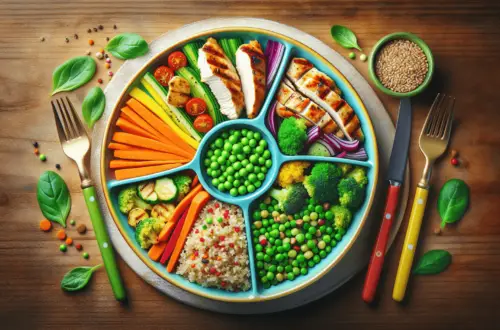In “How Does The Atkins Diet Promote Weight Loss?” you will explore the fascinating mechanisms behind one of the most popular weight-loss strategies of recent years. You’ll uncover how this low-carb diet shifts your body’s metabolism from burning glucose to burning fat, leading to effective and sustainable weight loss. By limiting your carbohydrate intake, the Atkins diet encourages your body to enter a state of ketosis, where it efficiently uses stored fat for energy. This article delves into the science behind this metabolic switch and offers insights into how making specific dietary choices can help you achieve your weight loss goals.
How Does The Atkins Diet Promote Weight Loss?
Have you ever found yourself wondering, “How does the Atkins diet promote weight loss?” This popular low-carb diet has undoubtedly made a significant impact on the world of health and nutrition. Whether you’re new to dieting or a seasoned expert, understanding how this diet works can be incredibly beneficial for your weight loss journey.
What is the Atkins Diet?
The Atkins Diet, developed by Dr. Robert Atkins in the early 1970s, is designed to help you lose weight by reducing your carbohydrate intake and increasing protein and fat consumption. The basic idea is that by cutting out carbs, your body will start to burn fat for energy, leading to weight loss.
The Four Phases of the Atkins Diet
The Atkins Diet is divided into four distinct phases: Induction, Balancing, Pre-Maintenance, and Lifetime Maintenance. Each phase has specific guidelines to help you transition from weight loss to weight maintenance.
| Phase | Duration | Carbohydrate Intake | Objective |
|---|---|---|---|
| Induction | 2 weeks or more | 20g net carbs daily | Kickstart weight loss by shifting your body to burn fat instead of carbs |
| Balancing | Until you’re 10 lbs from goal | 25-50g net carbs | Gradually introduce healthy carbs while continuing to lose weight |
| Pre-Maintenance | Until you reach your goal | 50-80g net carbs | Fine-tune your carb intake to maintain weight loss and prepare for lifetime maintenance |
| Lifetime Maintenance | Indefinite | 80-100g net carbs | Maintain your weight loss for the long term by adopting a sustainable, balanced diet |
How Does the Atkins Diet Work?
The Atkins Diet promotes weight loss primarily through ketosis, a metabolic state where your body burns fat instead of carbohydrates for energy. Let’s break this down further to understand how it all works.
Ketosis: The Cornerstone of Atkins
When you follow the Atkins Diet, reducing your carb intake significantly forces your body into a state of ketosis. This happens because your body no longer has enough glucose from carbs to fuel itself, so it starts converting stored fat into ketones, which are then used for energy.
Benefits of Ketosis
- Rapid Weight Loss: Since your body is burning fat for fuel, you’ll likely see quick results on the scale.
- Appetite Reduction: Ketosis can cause a decrease in hunger, making it easier to stick to your diet.
- Stable Energy Levels: Unlike the energy spikes and crashes associated with carb-heavy meals, ketosis provides a more consistent energy supply.
Reduced Insulin Levels
Another critical factor in weight loss with the Atkins diet is the reduction in insulin levels. Carbohydrates cause your insulin levels to spike, which can promote fat storage. By cutting carbs, your insulin levels remain lower, making it easier for your body to burn fat.
Increased Protein Intake
Protein is an essential part of the Atkins Diet and plays a significant role in weight loss. It helps to boost your metabolism, reduce your appetite, and preserve your muscle mass during weight loss.

The Science Behind Atkins
To fully grasp how the Atkins diet promotes weight loss, it’s useful to look at the science backing this approach. Numerous studies have shown that low-carb diets like Atkins can be highly effective for weight loss.
Research and Studies
Study 1: The New England Journal of Medicine
In a study published in The New England Journal of Medicine, participants following a low-carb diet lost more weight than those on a low-fat diet over six months. This study highlights the effectiveness of low-carb diets like Atkins in promoting weight loss.
Study 2: Annals of Internal Medicine
Another study in the Annals of Internal Medicine found that low-carb dieters lost more weight and had better improvements in heart health markers than those on a traditional low-fat diet over a one-year period.
How It Compares to Other Diets
| Diet | Carbohydrate Focus | Primary Mechanism | Common Foods |
|---|---|---|---|
| Atkins | Low-carb | Ketosis | Meat, fish, eggs, cheese |
| Keto | Very low-carb | Ketosis | Meat, dairy, oils |
| Paleo | Moderate to low-carb | Whole, unprocessed foods | Meat, fish, fruits, veggies |
| Mediterranean | Low to moderate-carb | Healthy fats and fibers | Fish, olive oil, fruits, veggies |
Meal Planning on the Atkins Diet
Now that you understand the science behind the Atkins Diet, let’s move on to practical aspects like meal planning and what you can eat during each phase.
Phase 1: Induction
During the induction phase, you’ll focus on very low-carb foods to kickstart the ketosis process.
What to Eat:
- Proteins: Meat, fish, poultry, eggs
- Fats: Olive oil, butter, avocado
- Low-Carb Vegetables: Spinach, kale, broccoli, cauliflower
Sample Meal Plan:
| Meal | Food |
|---|---|
| Breakfast | Scrambled eggs with spinach |
| Lunch | Grilled chicken salad |
| Dinner | Salmon with asparagus |
| Snack | Cheese sticks |
Phase 2: Balancing
In the balancing phase, you gradually reintroduce some healthy carbs into your diet.
What to Eat:
- All foods from Induction
- Low-Glycemic Fruits: Berries, melon
- Nuts and Seeds: Almonds, sunflower seeds
Sample Meal Plan:
| Meal | Food |
|---|---|
| Breakfast | Greek yogurt with berries |
| Lunch | Cobb salad |
| Dinner | Beef stir-fry with broccoli |
| Snack | Almonds |
Phase 3: Pre-Maintenance
This phase is all about fine-tuning your carb intake to sustain weight loss.
What to Eat:
- All foods from previous phases
- Whole Grains: Quinoa, brown rice (sparingly)
- Legumes: Lentils, chickpeas
Sample Meal Plan:
| Meal | Food |
|---|---|
| Breakfast | Omelet with mushrooms |
| Lunch | Chicken wrap in a low-carb tortilla |
| Dinner | Shrimp sautéed with spinach |
| Snack | Celery with peanut butter |
Phase 4: Lifetime Maintenance
This final phase focuses on maintaining your weight loss for the long term.
What to Eat:
- All foods from previous phases in moderation
- Healthy Carbs: Sweet potatoes, whole-grain bread (occasionally)
Sample Meal Plan:
| Meal | Food |
|---|---|
| Breakfast | Smoothie with almond milk, spinach, and protein powder |
| Lunch | Tuna salad with mixed greens |
| Dinner | Baked chicken with quinoa |
| Snack | Cottage cheese with herbs |
Potential Challenges of the Atkins Diet
Like any diet, the Atkins Diet comes with its own set of challenges. Knowing what to expect can help you better prepare and stay on track.
Common Challenges
Carb Cravings
You might experience intense cravings for carbs, especially during the induction phase. Having healthy, low-carb snacks on hand can help you manage these cravings.
Social Situations
Dining out or attending social events can be tricky. Planning ahead by checking menus or bringing your own low-carb dish can be helpful.
How to Overcome Them
- Stay Hydrated: Drinking plenty of water can help you feel full and reduce cravings.
- Find Support: Consider joining a support group or partnering with a friend for motivation.
- Meal Prep: Planning and preparing your meals in advance can help you stick to the diet, even when life gets busy.
Health Benefits Beyond Weight Loss
While weight loss is often the primary goal, the Atkins Diet offers several other health benefits.
Improved Heart Health
Studies have shown that the Atkins Diet can improve various heart health markers, such as reducing triglycerides and increasing HDL (good) cholesterol levels.
Better Blood Sugar Control
The diet can be particularly beneficial for those with type 2 diabetes or insulin resistance, as it helps to stabilize blood sugar levels.
Enhanced Mental Focus
Many people report increased mental clarity and focus while on the Atkins Diet, likely due to the stable energy levels provided by ketosis.
Is the Atkins Diet Right for You?
Before starting any diet, it’s essential to consider whether it fits your lifestyle, preferences, and health conditions.
Who Should Consider Atkins
The Atkins Diet may be a good fit for you if:
- You Struggle with Carb Cravings: The reduced carb intake can help manage cravings.
- You Need Quick Results: The diet is known for its rapid weight loss, especially in the initial phases.
- You Enjoy Protein and Fat: Since the diet is high in both, it’s easier for those who naturally enjoy these foods.
Who Should Avoid Atkins
The diet might not be suitable if:
- You Have Certain Health Conditions: Conditions like kidney disease can make high protein intake problematic.
- You’re Pregnant or Breastfeeding: Always consult your healthcare provider before starting a new diet during these periods.
- You Dislike Protein-Rich Foods: The diet relies heavily on them, so it might be hard to stick with if you don’t enjoy them.
Practical Tips for Success
If you decide to try the Atkins Diet, these practical tips can help you succeed.
Educate Yourself
Reading books, articles, and other resources about the Atkins Diet can provide valuable insights and keep you motivated.
Keep a Food Journal
Tracking what you eat can help you stay accountable and make it easier to identify any foods that might be stalling your progress.
Stay Active
While the Atkins Diet focuses primarily on diet, incorporating regular exercise can enhance your weight loss and overall health.
Monitor Your Progress
Regular weigh-ins and body measurements can help you track your progress and make any necessary adjustments to your diet.
Conclusion
So, how does the Atkins Diet promote weight loss? By reducing your carbohydrate intake, it helps your body enter a state of ketosis where fat is burned for energy. This diet also lowers insulin levels, increases protein intake, and has science-backed benefits beyond just shedding pounds. While it has its challenges, proper planning and support can make it a sustainable and effective weight loss strategy. Whether the Atkins Diet is right for you depends on your personal health needs and lifestyle, but with the right approach, it can be a powerful tool in your weight loss arsenal.





